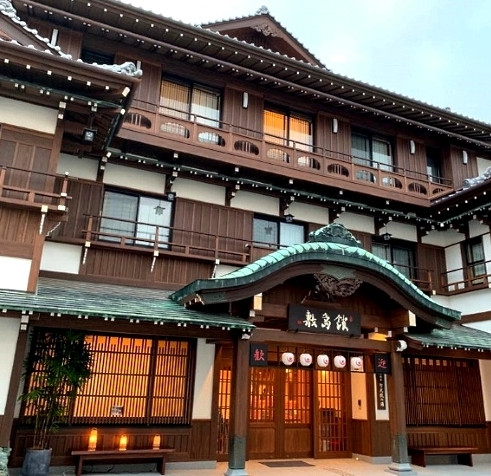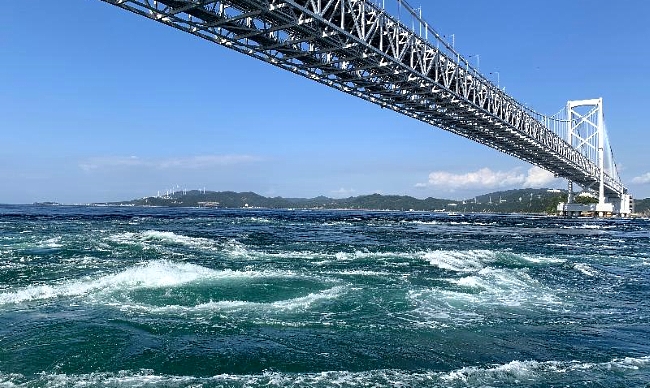By Lee San
I have watched at least 10 times Hayao Miyazaki's best-selling animation movie Spirited Away 20 years ago, and never actually get bored by it. The story is about little girl Chihiro, Haku and Yubaba inside a bathhouse. The story brings out the philosophies and tough experiences of life, and reminds me of yet another best-selling Hollywood animation film Avatar said to have drawn inspiration from the pillar-like hill formations in China's Zhangjiajie.
Where then is the bathhouse in Spirited Away modeled after?
Following the descriptions of Miyazaki, I arrived in the city of Matsuyama in Shikoku, and from there took the tram past the town center to the historic Dogo Onsen. I walked behind a large group of tourists through the shop-lined streets and saw a three-storey wooden structure reconstructed in 1894–the fabulous 3,000-year-old Dogo Onsen Honkan.

The Kami-no-Yu and Asuka-no-Yu buildings are said to be the scene of the Yubaba's bathhouse in Spirited Away. The bathhouse was awarded a Michelin 3-star in 2009, and I just can't wait to soak up myself with Chihiro!
To be honest, I quite like Shikoku. The island is not too big, just about 18,800 sq km, with a population of nearly 5 million. The history of Shikoku (Four Countries) could be traced back all the way to the era when Buddhism was first spread to the East from India. Because of that, the island is full of Buddhist temples and shrines. This speaks volumes of the fact the people in Shikoku have been very devout in the Buddhist faith for centuries.
I took the travel buddies all around Shikoku, enjoying the breathtaking scenery and savoring the freshly pressed mandarin orange juice from Ehime prefecture as well as Kochi's bonito sashimi roasted in strong fire on rice straw, plus a bowl of divine Sanuki udon, not to mention the A5 Kagawa wagyu teppanyaki I had booked for the evening!
Really, Shikoku is not inferior to Kyushu when it comes to food, and I feel the standard of food there is comparable to that of Hokkaido, and cheaper!
As our chartered flight was making the final touchdown at Matsuyama airport, the three-storey pagoda of Matsuyama Castle came into view.
We later took the cable car to the 132-meter Katsuyama. Having traveled in and out of Japan for almost three decades, I finally got to have a close encounter with Matsuyama Castle today, and the feeling was simply overwhelming!
Actually there are plenty of historic castles and ruins all across Japan, each with its own stories to tell. I took a good look at Matsuyama Castle's structure and building materials and realized what an architectural wonder it was, both in aesthetics and practicality.
Comparing it with the UNESCO-listed Himeji Castle in Hyogo prefecture, I really don't think Matsuyama Castle is any inferior. As a matter of fact, during the Shogunate Period in 682AD, there were more than 200 military fortresses built all across Japan, but few survived the subsequent wars. Notably, there are only 12 that have both the castles and tenshukaku towers still standing tall to this day, four in Shikoku alone, including Matsuyama Castle!
Talking about the Shogunate Period, the military governments constructed castles and fortresses while the daimyo (feudal lords) were more inclined to building private garden mansions.
Built in the late 16th century during the heyday of the Shogunate Period, the Ritsurin Garden in Kagawa prefecture instantly became one of Japan's top four gardens! I was wondering how the Japanese managed to upkeep the garden over the past 500 years! Today, Ritsurin Garden has received the highest three-star honor from Michelin. There is a restaurant inside the garden where you can enjoy a simple teishoku lunch before you continue enjoying the garden.

Surrounded by the sea on all sides with towering mountains in the middle, Shikoku has its share of natural marvels that you should not miss. The swift rapids of Oboke Gorge in Tokushima, for instance, are flanked by steep natural rock walls. Additionally, the 20-meter high Naruto Strait whirlpools, among the world's top three, are simply awe-inspiring.
While I was studying in Japan, I once drove from Okayama prefecture in Honshu, past the epicenter of the 1994 Kobe earthquake on Awaji island, onward to the 1.6km Naruto Bridge, from where I could see the natural whirlpools created by rising and falling tides.
But this time, I took a boat direct to the big and small whirlpools where the Seto Inland Sea and the Pacific Ocean meet, and experienced up close the 20km per hour swift currents at work.
On the New Year Eve night, at the Kotohira-gu in Kagawa prefecture, I walked up the 1,368 steps with my travel buddies and devotees from all over Japan towards the 521-meter Mount Zozu to pay homage to Konpira–the patron deity of the sea–for world peace, as we prepared to count down to the first daybreak of 2020.
Sadly, the Shikoku trip was my last to Japan before the coronavirus outbreak. And we all know what happens to our world thereafter.
PS: Let's make a date for Shikoku once Japan reopens its borders!
(Lee San is Founder and Group Executive Chairman of Apple Vacations. He has traveled to 132 countries, six continents, and enjoys sharing his travel stories and insights. He has also authored five books.)
ADVERTISEMENT
ADVERTISEMENT


































